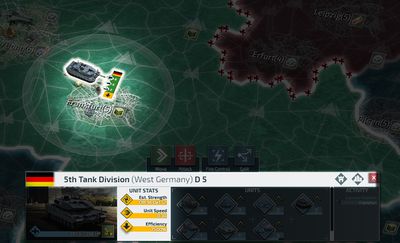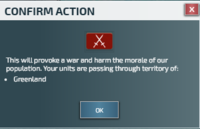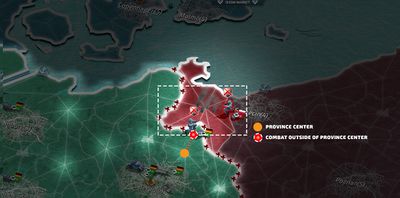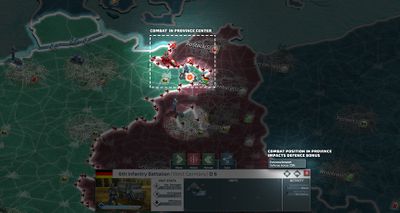Difference between revisions of "Combat"
From Conflict of Nations Wiki
| Line 15: | Line 15: | ||
<h3>Army Stacking Penalties</h3> | <h3>Army Stacking Penalties</h3> | ||
<div> | <div> | ||
| − | + | <div class="img-block-center"> | |
| − | |||
| − | |||
| − | <div class="img | ||
[[File:Effiency box arrow high.png|class=nolink|High efficiency]] | [[File:Effiency box arrow high.png|class=nolink|High efficiency]] | ||
[[File:Effiency box arrow mid.png|class=nolink|Medium efficiency]] | [[File:Effiency box arrow mid.png|class=nolink|Medium efficiency]] | ||
[[File:Effiency box arrow Low.png|class=nolink|Low efficiency]] | [[File:Effiency box arrow Low.png|class=nolink|Low efficiency]] | ||
</div> | </div> | ||
| + | [[File:STACKING PENALTY.jpg|fig1 - Low efficiency stack|thumb|right|text-top|400px]] | ||
| + | One of the most important changes to modern combat is in the relatively low number of combatants involved. Today’s invasions play by the factor of 10 or lower. To simulate modern logistics and fire-and-manoeuvre doctrines, you will notice a strict stacking penalty for units. Expect to see diminishing returns, and even negative modifiers, in combat strength, movement speed, and defensive capabilities. | ||
| + | <br><br> | ||
If marked yellow, the unit stack suffers from diminishing returns, i.e. every additional unit added to the stack makes it less effective. Once the indicator turns red your stack begins to suffer. | If marked yellow, the unit stack suffers from diminishing returns, i.e. every additional unit added to the stack makes it less effective. Once the indicator turns red your stack begins to suffer. | ||
</div> | </div> | ||
Revision as of 12:44, 6 March 2018
Commander, combat is the most important element of a successful military campaign in Conflict of Nations.
Contents
Combat at a Glance
Combat aims to establish total dominance over an opposing force. To succeed, you must hone your tactical awareness. As commander of an entire nation, you need a deep understanding of the intricate details of modern war. Study the mechanics of close-combat attack and defence, as well as how combat might play out in different scenarios. Victory goes to the prepared.
- Diligence - Anticipate diplomatic interference and counter attacks, as well as growing insurgent areas.
- Effective strategy - Think ahead and don't waste resources. Every decision counts, especially when you are investing realtime.
- Resources - Keep an eye on your resource production. Consider provinces and cities that you require for further Arms Industries construction. If new territory is hard to acquire on your own, ally with someone.
- Diplomacy - Diplomatic relations will make or break the game and must not be undervalued.
The Tools of War
Army Stacking Penalties
One of the most important changes to modern combat is in the relatively low number of combatants involved. Today’s invasions play by the factor of 10 or lower. To simulate modern logistics and fire-and-manoeuvre doctrines, you will notice a strict stacking penalty for units. Expect to see diminishing returns, and even negative modifiers, in combat strength, movement speed, and defensive capabilities.
If marked yellow, the unit stack suffers from diminishing returns, i.e. every additional unit added to the stack makes it less effective. Once the indicator turns red your stack begins to suffer.
Missile Warfare
Modern battlefields are extremely hostile due to the very high amount of damage concentrated in very small delivery systems, such as Cruise Missiles.
Conflict of Nations allows dedicated air, ground, and naval units to fire conventional, chemical, and nuclear cruise missiles at military targets, amongst others.
The strategic use of ballistic and intercontinental missiles of varying size, and payload, is simulated in the game.
Tactical Terrain
Terrain plays a vital role in planning conquests. From the jungles of the Amazon, to the icy wastes of Greenland, the terrain places specific demands on the men and machines in this game. Simply pull up the terrain mode in the lower right game corner and plan your optimal tactics.
![]()
![]()
![]()
![]()
![]()
![]()
![]()
![]()
Entrenching
Placing a unit stack on a provincial center-point will provide a defensive entrenchment bonus while it remains there. This is automatic and stops once the unit is ordered to move on. The entrenchment bonus can be increased through the construction of certain buildings.
Retreating
Should units ever start getting mauled badly; players can order them to retreat to a neighbouring friendly territory at a cost of hit points. Naval and Ground units are the only units able to use the retreat feature.
Unit Healing
Building military hospitals will speed up the recovery time of units low on HP. Generally, ground units will recover a small amount of HP over the course of time when in friendly territory. Just as naval vessels repair over time when in shallow waters.
Hardened Bunkers
Rather than creating an invincible fortress, today’s city defences are all about providing civil protection against weapons of mass destruction. The better equipped a city is, the more of its population will survive any serious attack. There is of course, some military value in hardened positions as well.
Crimes against Humanity
Units sent into enemy cities that are not yet conquered will start decimating the local population. This is considered a war crime and can have severe consequences with the morale of the player’s population – especially if large numbers of civilians suffer from this behavior.
Chemical and Nuclear Warfare
Probably the strongest weapons ever invented, these are the ultimate killers – albeit with a double edge. The resulting loss of life, devastation and contamination wrought by one of these weapons of mass destruction will not go unchecked by other nations and of the perpetrator’s own population. In Conflict of Nations there is the real chance of the world turning into a contaminated wasteland, populated by unhappy survivors. We warned you…
Insurgents
Insurgents are a special unit that pop out in a city as a rebellion mechanism. They are trained former military who are not easy pushovers because they are fighting for something they truly believe in, even if the “good guys” disagree, making them formidable and dangerous enemies. Even though they don't physically march into the city, they should be considered an attacking unit and treated as in the scenario "Offensive/ Defensive Engagement"- where the Insurgents are the Offensive unit.
Stealth Units
Stealthed units can have both meeting and offensive/defensive engagements, but on top of this, there is a First Strike / Ambush Bonus Damage.
Anti-Air vs Missiles
When you launch missiles against a target, we distinguish between two cases:
Point Defence
If the stack that your missile is attacking is/contains an anti-air unit, the combat tick is calculated as Point Defence. This means that the anti-air unit will defend itself every time against incoming missiles, i.e. there is no cool-down.
For example: You fire two missile against an anti-air unit. It does not matter whether you fired your missiles one second or one hour apart, anti-air will defend against them every time.
AA Envelope
If the stack that your missile is attacking is a unit that is standing within anti-air range, but is not part of the same stack, the combat tick is calculated as AA Envelope. This means that the anti-air unit will go on cool-down before it can defend a close-by unit again.
For example: You quickly fire two missile against an infantry unit that is standing within an anti-air unit's envelope that is standing close by. You fire another missile directly at the anti-air unit as well. The first missile, aimed at the infantry unit, is shot down by the anti-air unit. The second missile, however, lands a hit on the infantry unit since the anti-air unit's envelope is on cool-down. The third missile, directly aimed at the anti-air unit, is shot down since it is calculated as Point Defence.
Acts of War
Declaring War through the Diplomatic Panel
To declare war, click the Diplomacy button and select the target player. Then, from the drop-down menu, change your status from Peace to War. You could even be diplomatic about the process and send a note stating your justifications for doing so, but most commanders won’t be so kind.
Declaring War through Invasion
Most attacks happen by default, when your army meets the enemy at a border, or when you trespass the province/city of a country with which you do not share a special diplomatic relationship. You will receive a pop-up warning whenever your move order would constitute an act of war. If you do want to attack the other player, ignore the pop-up, and move your units to a location. Fighting will commence.
Note: If you want to avoid going to war with another country, remember that your diplomatic status with that country needs to be one of the following:
- Right of Way
- Military Pact
- Security Council Shared Intel
If you do not have either one of these statuses then you will be seen as aggressive and effectively declare war on the opposed country.
If, while on your travels outside your homeland, you meet hostile forces, your troops will fight the hostile army. If your forces win, the remaining troops will continue to the original destination.
Note: It is entirely possible that other players have chosen the same enemy target as you (I know great minds think alike). So if another player captures a province before you, YOUR units will continue their advancement and attack the city, and so declare an undeclared war on the other player (if you were not at war).
To avoid this I recommend you do not attack the city itself with your original orders. Instead target the enemy garrison within the city. To do this simply select the army in the city as your primary objective and if these units are hidden with a “?” then target the flag that flies over the city.
Note: Choose your targets carefully. If you declare war on a lot of nations simultaneously, your homeland country and people will suffer.
Changes to Population Morale
War Affects Morale
When you declare war, it does not just affect your troops, but also your nation as a whole. This War Penalty affects your Homeland civilian morale which can affect your production as well as your troop morale. The penalty is a subtracted 5% to your population’s morale for every country you are at war with.
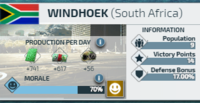
To find your war penalty, click on one of your territories and press the "i" button beside "Morale" in the province pop up (local Population Morale) This will also show you what else affects morale in a province including distance to capital, energy shortages and neighbouring province morale.

Battle Stats and Report Generation
In Conflict of Nations, battle results are aggregated and updated every hour. Undefended, hostile provinces that you have conquered are excluded from this report. You can find these results ingame in the CoN News feed.
Combat Mechanics
How Core Combat is Designed to Work Ingame
Generally, combat rounds take place every hour. We differentiate between four possible scenarios:
- Meeting engagements
- Attack/Defence engagements
- Edge cases
- Cases where two armies are in movement
There is mention in this section of Insurgents and Stealth Units, before getting into the actual Mechanics of a Single Close Combat Attack Round. In every combat round, both armies conduct an attack round on each other, so basically the damages dealt are DOUBLE that of city combat (effectively combat is 2x faster). Also important to note, is that strongly defensive units will suffer more if caught in the open.
Meeting Engagement
Scenario: Army A attacks army B in the open - where army B is stationed outside of the province's center-point.
First Combat Tick (immediately):
- Army A attacks army B using its offensive stats
- Army B defends against army A using its defensive stats
- Army B counter-attacks army A using its offensive stats
- Army A defends against army B using its defensive stats
Second Combat Tick (after 1 hour has passed):
- Army A attacks Army B using its offensive stats
- Army B defends against Army A using its defensive stats
- Army B counter-attacks Army A using its offensive stats
- Army A defends against Army B using its defensive stats
- and so on...
Attack/Defence Engagement
Scenario: Army A attacks army B - where B is stationed on the province's center-point.
When army B is entrenched on a province's center-point, it is not performing offensive actions. Only army A conducts attack rounds, while army B is just defending.
First Combat Tick in chronological order - first exchange between the two armies, happens immediately:
- Army A attacks army B using its offensive stats
- Army B defends against army A using its defensive stats
Subsequent Combat Ticks in chronological order - hourly after FCT:
- Army A attacks army B using its offensive stats
- Army B defends against army A using its defensive stats
- Army A attacks army B using its offensive stats
- and so on...
Edge Cases
Army A is moving without attack order, Army B is stationary either outside of, or on a map point. If Army A is moving because of a move order, while Army B is just standing around, it works the same way as in Scenarios 1 and 2 depending on B's position.
- Effectively, moving is actually identical to ordering an attack, even if Army A doesn't anticipate a fight,
- The only difference is with regards to ranged units, wherein they only move into melee range, whereas they will open fire if ordered to attack once they are in range
Cases Where Two Armies are in Movement
Army A and Army B run across each other while moving on the map no matter if outside or on a map point If Army A and Army B are both moving without an attack order and then close within combat range- Scenario 1 applies
The Mechanics of a Single Close-Combat Attack Round
- The system looks at the position of the target army. It draws a circle of size around it and labels it “default Splash Radius”. All armies within the radius form the "splash armies". Let's call these armies within the area of defence, the "defending armies".
- The system calculates total damage done by the attacking army, for all damage types, based on their offensive stats.
- The system calculates the total damage done by all of the defending armies, for all damage types, based on their defensive stats.
- The system applies the defender’s damage to the attacking army and removes units if needed. The system generates kills and produces News Articles if needed.
- The system applies the attacker’s damage to the defending armies, splitting it up based on the damage area of the individual defending armies, compared to their total damage area excluding "fast flying units" which are not taking damage. The system removes units and produces News Articles.
- The system applies building damage to the province, based on the damage done by both the attackers and the defenders.
Attack-Defence Scenarios
Scenario A
If the countries are at war;
- German army (1 light infantry) stands on the road.
- Polish army (1 light infantry) gets a move order to walk ‘through’ the German army and attack the city behind them.
- Countries are at peace until the attack happens.
- Attack happens on German soil.
- Result: German attacking, Poland attacking.
Scenario B
- German army (1 light infantry) stands on the road.
- Polish army (1 light infantry) gets an attack order on the German army.
- Countries are at peace until the attack happens.
- Attack happens on German soil.
- Result: Germany attacking, Poland attacking.
Scenario C
- Same as Case 1, but countries are at war before the attack happens.
- Result: Germany defending, Poland attacking.
Scenario D
- Same as Case 2, but countries are at war before the attack happens.
- Result: Germany defending, Poland attacking.
Scenario E
- Polish army (1 light infantry) stands on the road on German soil.
- German army attacks the Polish army.
- Countries are at war before the attack happens.
- Result: Germany attacking, Poland defending.
Scenario F
- Same as Case 5, but the countries were at peace when the attack happened
- The diplomacy status changed to 'at war' immediately
- Result: Germany attacking, Poland attacking
In summary, if the two countries are at peace, both armies will be assigned the "attacking" status regardless of who started the fight or on which land they are standing.
The "attacking" status and the other army the "defending" status, regardless of which land they are standing.
The X-Factor
Commander, no matter how well you draw your battle plans not all battles are the same and face uncertainty!
So it is IMPORTANT to note that terrain type, unit morale, tech level and numbers will have an important part too play in battles/conflicts in CoN.
However, the "X" Factor (and no not the singing competition) also known as the "possibility" factor for determining battle results.
This is a randomly generated number that adds some randomness and excitement to a battle so nothing is ever the same and always something different to experience.
This battle calculator is a Key feature of the game coding behind CoN, which is what makes the game enjoyable as no battle outcome is always the same and so not always predictable.
This X-factor keeps the game fun and enjoyable as not every battle will have the same outcome.
Advance with Caution:
Choose your target carefully. Your divisors advise you not recommend declare war on a lot of nations as your country and people will suffer if you are fighting many wars at once.
Note: As the game devolops and beta continues the game will update and will be in a state of change until out of beta so some info here may become outdated.
